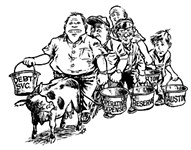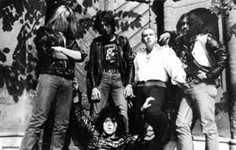Two Kids in the Bush
Council Nixes Plans for More Cops on Hand
By Alex de Marban, Fri., Oct. 18, 1996
As it is, the department is almost 100 officers, about 10%, below the authorized level. And while a class of approximately 45 cadets will graduate in December, a rash of veteran employees taking advantage of a new retirement plan will keep the level static; it will be another three years before the department will produce a surplus of officers. Things are so tight Police Chief Elizabeth Watson is changing the way she measures the size of the force, so the reduction won't be as apparent (see The Austin Chronicle, September 6). Moreover, this fiscal year she had to bolster her depleted front-line with five police officers from the city's community police programs: D.A.R.E., a youth program whose acronym stands for Drug Abuse Resistance Education; and COPS, a neighborhood policing program.
Meanwhile, the city's crime rate is still a booming business for criminal lawyers. Official figures released by the department last week show that in the first six months of 1996, violent crime is down by only .3% from the same time period a year ago. And police officers say a rash of homicides from July to the present will worsen that figure. Also, the figures show that property crimes are up by 2.2%.
Police Chief Elizabeth Watson says that she is doing what she can with the resources she's been given -- the only option to get more police on the streets is to make the department more efficient, something that Austin Police Association (APA) officials say they've been working on. Consider the so-called Take Home Car Program, which APA members like Sheffield, who is vice-president of the employee organization, say could halve the shortfall in patrol officers, and save beaucoup money.
Currently, the average patrol car is driven 16 hours a day in two shifts. To pick the car up, officers must drive to one of the city's two substations, the North or the East substation. According to APA figures, the average police officer spends 40 minutes commuting to work and another 40 minutes readying the car for patrol.
Under the plan, each of the city's approximately 500 patrol officers would
take their own car home. The cars would be driven approximately half as much,
according to APA figures, so, in theory they would last twice as long.
Currently, the entire fleet would have to be replaced over a five-year period.
If the program were implemented tomorrow, the APA estimates a $9.6 million
price tag. That's expensive, but in a climate where some councilmembers
advocated $400,000 more than that to build a baseball stadium, it seems fair to
the APA. With the
$9.6 million, the police department could purchase 300
police cars, and an additional 200 could be added from the current fleet. The
savings would be immediate. Each patrol officer would be on the streets an
extra 80 minutes a day, equalling 61 additional officers a year, the APA
estimates. The average officer makes $42,000, so it would save $2.5 million.
Sheffield maintains, "In four years you've paid for the start-up costs." The only drawback, he cracks, is that "you don't get professional baseball."
With the plan, twice as many patrol cars would be on the streets during the morning and evening shift changes. During the 41/2 hours a day the patrol force spends in shift changes, the number of officers on duty is cut in half, leaving some neighborhoods unpatrolled. Under the program, there would be no en masse shift changes, so all neighborhoods would remain covered throughout the day. And with patrol cars disbursed at officers' houses throughout the city, instead of sitting at the substation, for example, neighborhood residents would feel safer, and criminals wouldn't. To further promote visibility in high-crime neighborhoods, the APA also suggests a city program offering housing loans to officers willing to move to less-desirable areas.
But the program may be too good to be true, given its one major shortcoming: "It's just too logical for the council to understand," laments APA president Mike Lummus.
If you sat through last week's generously short councilmeeting, you may have come away with that same impression. During a public hearing called by Jackie Goodman, neighborhood leaders from across the city prevailed on the council to fully reinstate the COPS and D.A.R.E. programs. And more generally, the dozen or so leaders, primarily from the Southeast Corner Alliance of Neighborhoods and the Northwest Alliance of Neighborhoods, wanted increased police presence in their areas.
Goodman sponsored a resolution to have city staff consider reinstating the
popular community programs, and to study the feasibility of the APA-suggested
plans. Gus Garcia, Beverly Griffith, and Daryl Slusher abstained, and with the
mayor absent, it saw a quick death. Of course, the proposal was one of
Goodman's last-minute, out-of-thin-air creations that she's fond of, and the
three abstaining councilmembers thought it amended the budget they had just
approved. They pointed out that they had already added
$3 million to the
police budget, and, just as importantly, had added $1.4 million in prevention
measures for youth, namely, Griffith's Social Fabric Initiative.
Instead of putting more money into police, Garcia made a call-to-arms that neighborhood residents help the police, and recounted a heroic tale of how he had saved his own high-crime neighborhood in Northeast Austin one night. Garcia related how, when he was walking one evening near his home, he heard some noises in the bushes. Were they human voices? Was it an animal? Instinctively, nary a thought for his own safety, the 62-year-old parted the hedges... It was... It was... two kids from another neighborhood. Garcia told them to go home and do their homework. "My wife said, `How could you do that, they could have had guns?' Well, they could have but they didn't."
During that tale, APA vice-president Sheffield, could not help but think of Bolin, and what Garcia, Slusher and Griffith's decision to abstain meant to public safety. "Gus Garcia reduces it down to this. What if it's two burglars in a bush? What are you gonna do, spank 'em? It'd be nice if neighborhoods could do everything, if this neighbor and that neighbor would stop the bridge game and go investigate the latest homicide. But one man's reality is another man's fantasy. The real solution is to put more police on the streets."
This week in council: no meeting.
Got something to say on the subject? Send a letter to the editor.








